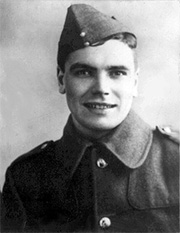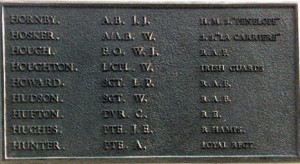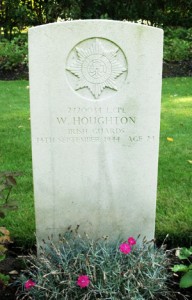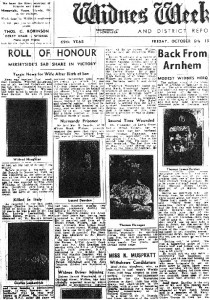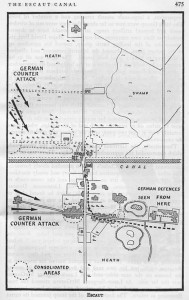As a young lad, I would often spend my summer holidays at my grandparents’ house in Appleton Village, Widnes which was just across the road from the entrance to Victoria Park, where I spent much of my time playing. There is a war memorial in the park and I remember seeing a Houghton on the list, but at the time I didn’t really give it much thought. It was only years later in conversations with my grandmother that I discovered that he was actually one of the family.
During one of these conversations, my grandmother revealed a fact that she told me wasn’t widely known outside the family: Wilf was raised by his grandparents as their son. His mother was actually my grandfather’s sister, Charlotte Beatrice HOUGHTON, or ‘Aunty Beattie’ as she was known. The story goes that Beattie and Wilf’s father wanted to marry but her parents wouldn’t allow it. This and Wilf’s untimely death were to have a profound effect on Beattie, as later events were to reveal. My grandmother didn’t know very much more about Wilf other than that he served in the Irish Guards and that he was killed in a tank in what she called the ‘Njimegen bridge disaster’ during World War II. I later discovered that the Irish Guards were involved in operation Market Garden in 1944, a campaign immortalised in Cornelius Ryan’s “A Bridge Too Far”.
I tried to find out more about Wilf but struggled to know where to look. I was then fortunate enough to hear an article on BBC Radio 4 announcing that the Commonwealth War Graves Commission was making its database of those who were killed in service available for searching at its web site. My excitement turned to disappointment upon I finding that the site was overwhelmed by visitors and inaccessible for several days. I eventually managed to load the search page and enter Wilf’s name. After what seemed an age I was presented with a page of W. Houghtons which contained the entry for a Lance Corporal in the 3rd Battalion Irish Guards, Service Number 2720034, who died on the 14 September 1944 aged 24. A link on the page gave details of the cemetery location (Geel, Antwerp), grave number and a brief history of the fighting in that area.
Armed with Wilfred’s age and date of death, I arranged a visit to the library in St. Helens (this was pre Internet!) to use one of their microfilm readers in order to search their archives of local newspapers. It was not long before I found what I was looking for in the Widnes Weekly News: on the front page of the 6th October 1945 issue was a list of casualties and there, alongside a picture of Wilf (unrecognisable due to the poor quality of the image), was a short article which revealed yet another sad aspect to the story: Wilfred’s wife Jean was told of his death on the day of the birth of their first child.
The article reads: “Roll of Honour – Merseryside’s Sad Share in Victory – Tragic News for Wife After Birth of Son – News was received last week that Corporal Wilfred Houghton, son of Mr Samuel Houghton and the late Mrs Elizabeth Houghton, 365 Warrington Rd Widnes had been killed in action in North West Europe. He was 25 years of age, an old boy of Simms Cross School. Before joining a regiment of the Guards in November 1939, he was employed at the Everite and was at one time a member of the Scout troop. Eighteen months ago he was married to Miss Jean Williams of Clydebank Glasgow. Mrs Houghton gave birth to a son a few hours before she received the news of her husband’s death.“
In the following years, several in memoriam notices were printed in the local papers; all the more poignant given what we know:
Runcorn Weekly News, 14 June 1946: “In treasured memory of of my dear mother Elizabeth Houghton, who passed away on June 14th 1944; also our dear Wal (Cpl. Wilfred Houghton, Irish Guards), who was killed in action, September 14th 1944 (N.W.E., B.L.A.) – Sadly missed by Beatrice (our Bea), 11 Wellington St, Runcorn.
Widnes Weekly News, 13th September 1946: “In treasured memory of our dear Wilfred, Corporal Irish Guards, who was killed in action (N.W.E.) on September 14th 1944. – Sadly missed by May, Clarry and family; also Beatrice (our Beat), 11 Wellington St, Runcorn. Till memories fade and life departs you will live forever in our hearts.“
Widnes Weekly News, 12th September 1947: “In memoriam Houghton, in treasured memory of our dear Wilfred, Corporal Irish Guards, who was killed in action NWE on September 14th 1944. Sadly missed by Beatrice, 11 Wellington St, Runcorn. Till memories fade and life departs you will live forever in our hearts.“
The only thing that anyone in the family could remember about Jean was that she was from Scotland and that after Wilf’s death she moved back to be with her parents.
For many years, the story ended for me at this point, but while browsing on a genealogy surname list I chanced upon a post by someone looking for their grandfather, Wilfred HOUGHTON from Widnes who died aged 24 and was in the Irish Guards. I had found Wilfred’s grand-daughter!
I subsequently obtained Wilfred’s birth certificate, which confirms that his mother was [Charlotte] Beatrice HOUGHTON of 26 Foster St, Widnes with no father listed. I also sent away for Wilfred’s marriage certificate which confirms that Wilfred HOUGHTON (engineers machineman, Irish Guards and a bachelor), from 365 Warrington Rd, Widnes married Jeanie Compston WILLIAMS (sewing machine factory machinist and spinster) of 34 Singer St, Clydebank in 1942. Jeanie’s parents were Thomas WILLIAMS (clerk, ordnance factory) and Agnes WILLIAMS, maiden surname DONALDSON.

While sorting though a bag of family photos I found a negative which not only gave me another photograph of Wilfred but also provided me with the only image I have of my great-grandfather Samuel HOUGHTON. The negative was in very good condition and I have been able to obtain a decent scan (reproduced above).
An earlier article in the Widnes Weekly News (22nd November 1941) is a birthday announcement for Wilfred along with an accompanying photograph (from which the portrait at the top of this page is taken). The text of the article reads: “Brothers in arms – Birthday Congratulations – Among the many Widnes families who have several members on service with H.M. Forces is that of Mr and Mrs S Houghton, of 365 Barrows Green Lane, who will have the joy on Sunday (November 24th) of celebrating the coming of age of one of their two sons, Guardsman Wilfred Houghton. His elder brother, Sergeant James Houghton is on service with the Military Police.
Guardsman Houghton is in the Irish Guards. He joined up in January last year and was soon drafted to the B.E.F. He was safely evacuated from Bologne and is now on service in this country. He was educated at Simms Cross School and before enlisting was employed at the Everite Works of Messrs Turners Asbestos Cement Company. He was a member of the Everite Scouts. As stated he will be 21 years old on Sunday.
Sergeant Houghton is 39 years of age and is resident in Croydon. He served for 12 years with the Scots Guards. He is an old boy of Warrington Road School.“
Operation Market Garden
Wilfred was killed three days before the start of Operation Market Garden, an audacious attempt by the Allies to capture and hold the bridges across the major rivers and canals in north west Europe so that they could gain entry to Germany from the north.
I am indebted to Phil Jennett, and Diane at the former WW2Guards website (now defunct) for providing me with information from the battalion War Diaries and regimental history, which details the action that took place of the fateful day and which I reproduce with their permission below:
From the War Diary of the 3rd Battalion Irish Guards
UNIT – 3RD BATTALION IRISH GUARDS
COMMANDING OFFICER – LT. COL. J.O.E. VANDELEUR
MONTH AND YEAR – SEPTEMBER 1944
PLACE & DATE & SUMMARY OF EVENTS AND INFORMATION
September 14 de GROOT 08:00hrs
An enemy counter-attack was launched in some strength against the bridge head. A number of the enemy with spandaus and bazookas succeeded in infiltrating into the area held by No 3 Coy on the left, and the whole Bn and the bridge itself were subjected to fairly heavy mortar and shell fire throughout the day. During the evening, although the attack had by then been halted, we were compelled to re-organise to closer dispositions that those we had previously held. At nightfall, the shell and mortar fire intensified and was subsequently proved to be a cover for the enemy’s withdrawal, as there were no signs of them the following morning.
During the day, Lt. KENNARD and six ORs were killed, 23 ORs wounded and five ORs missing, but on the whole, casualties were lighter than might have been expected as the result of a two Bn co-ordinated attack.
Below is a transcription from the published history of the regiment for the events of the 14th September:
Reproduced from The History of the Irish Guards in the Second World War by D.J.L. FitzGerald (1949), Page 481
[Escaut Canal]
The less fortunate and more tired 3rd Battalion remained in the bridgehead for more fighting. Early on the morning of the 14th [September] the Germans launched two battalions in a heavily supported counter-attack. The weight of it fell on No. 3 Company on the left flank. Waves of Germans seeped through the thick woods and scrub, firing bazookas as they came and setting up Spandaus beneath the trees. They surrounded first the forward section and then the whole of Lieutenant H. KENNARD’s platoon; the fighting degenerated into savage slaughter among the bushes. Humphrey KENNARD was killed leaping from bush to bush. In such fighting weight of numbers was bound to prevail, and the platoon would inevitably be swamped if it were not reinforced or extricated. Captain Michael DUDLEY, the Company Commander, wanted to send up a tank, but the platoon was half a mile away through tangled, enemy-infested wood. Guardsman MOYNIHAN, the Company runner, said he knew the best way. Walking through the rides, he led the tank up to the platoon, reported back to Captain DUDLEY, and then returned again to withdraw the platoon. He brought back the survivors without losing a single man on the journey.
The fighting continued all day, and all day the wood and the bridge were heavily shelled and mortared. During the afternoon the Company launched an attack to regain the lost ground. The Guardsmen scrambled through the undergrowth, shooting and grinding their way forward. Sergeant McELROY led his platoon, shouting encouragement to his section commanders and bayoneting the Germans. A bullet struck him in the foot, but he charged on, leaving a trail of blood on the dead leaves. They retook the position and threw the Germans out of their old trenches. When Captain DUDLEY came up to see the platoon he found Sergeant McELROY hobbling around, a boot on one foot and a shell dressing on the other. Captain DUDLEY took him back protesting to Company H.Q. and told him to go to the R.A.P. Sergeant McELROY went down the path, but turned back into the wood, and was back with his platoon when Captain DUDLEY returned there. This time he had to be forcibly evacuated with a reliable guard.
Meanwhile the German fire was intensifying. The Battalion expected another attack, but the barrage turned out to be a cover for the enemy’s withdrawal. The Germans had given up the effort to retake the Escaut bridge. In the attack and counter-attack the Battalion lost 7 men killed, 23 wounded, and 5 missing – bad enough, of course, but much lighter than might have been expected in beating off two German battalions. The following morning they handed over their positions to a battalion of Hampshires from 50th Division, and moved back out of the bridgehead to join the 2nd Battalion at OVERPELT to rest, reorganise and study the plans for Operation “Market Garden.”
